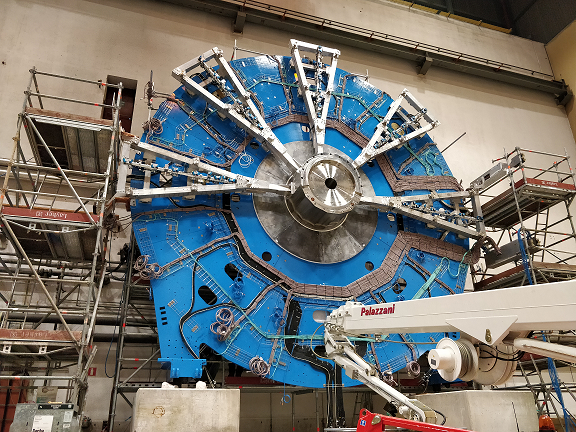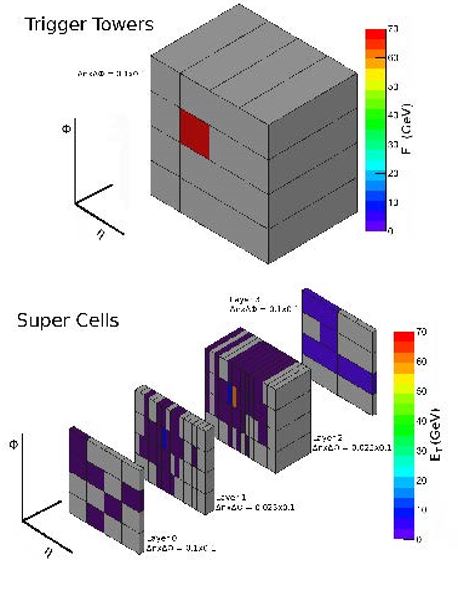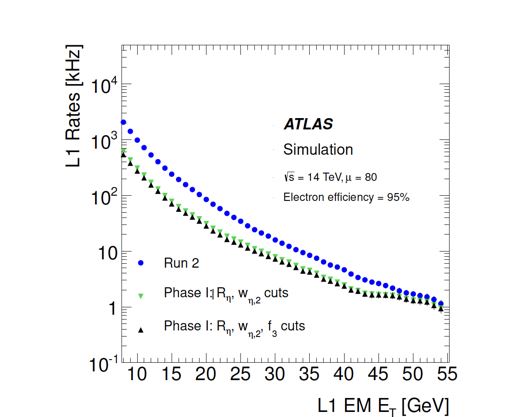The LS2 period for the ATLAS detector
The main upgrade activities are all aimed at enhancing the capability of the detector to trigger more efficiently on leptonic and hadronic signatures. In particular it is essential to preserve the ability to trigger efficiently on electron and muons with transverse momentum of ~20 GeV. With the instantaneous luminosity expected for Run 3, this implies to improve the selectivity of the trigger system.
To improve the selectivity of the electron trigger, the amount of information used for the trigger decision will be drastically increased. In fact, up to now, the very fine-grained information produced by the electromagnetic calorimeter is grouped in “trigger towers” of relatively big size, to limit the number of trigger channels (Fig. 1).
Figure 1: The so-called trigger towers in which information is stored by the ATLAS electromagnetic calorimeter.
This was needed in the original design of ATLAS (1995-2000) to limit the cost and the amount of cables. Nowadays the technological evolution in electronics and in data transmission with optical fibers allows the transmission of a much larger amount of information at a reasonable cost. By replacing some components of the front end electronics of the LAr electromagnetic calorimeter, the level of segmentation available at the trigger level will be increased fourfold, improving the ability to reject jets and preserve electron and photons, while keeping the trigger rate at the current level (see Fig. 2).
Figure 2: The foreseen improvement of the ability to reject jets and preserve electron and photons by the scheduled upgrade of the LAr electromagnetic calorimeter.
The Trigger and Data acquisition (TDAQ) systems will also be upgraded by introducing new electronics boards aimed at analyzing the more granular trigger information coming from the detector. To this end, three different types of boards have been designed and are in fabrication: the eFex (electron feature extractor), jFex (Jet Feature extractor) and gFex (Global feature extractor). These new boards will be installed and commissioned together with all the other read-out and trigger electronic boards that complete the TDAQ upgrade, throughout the whole LS2 period.
The inner layer of the forward region of the ATLAS muon spectrometer is being upgraded with the construction of the so-called New Small Wheels (NSW), as shown in Fig. 3. below.

Both tracking capabilities in presence of large background and triggering capabilities will be improved with respect to the present Small Wheel, introducing new detector technologies Micromegas and sTGC. Both technologies will be able to withstand the higher flux of neutrons and photons expected to be created in the LHC interactions, which will produce counting rates as high as 15-20 kHz/cm2 in the inner part of the NSW, and deliver trigger information at the first-level trigger.
The main aim of the NSW is to reduce the fake muon triggers in the forward region and improve the sharpness of the trigger threshold drastically, allowing the same selection power as the present High Level Trigger (HLT=computing farm) at the first-level trigger (made in hardware). This will be achieved by measuring precisely the angle of the muon candidate at the NSW location, together with the measurement of the candidate muon’s direction in the Big Wheel, after being deflected by the strong magnetic field of the End Cap Toroid.
Other smaller upgrades will be deployed during LS2, including the installation of 16 new muon chambers made of small-tube Monitor Drift Chambers (sMDT) and Resistive Plate Chambers (RPC) in the inner layer of the barrel spectrometer.
The organization of the LS2 period is a very complex exercise in which the maintenance needs of the detectors and of the main general infrastructures (electric distribution cooling and ventilation, detector cooling) have to be combined with the plans of installation of the upgrades previously described.
Figure 4 shows a sketch of the activities scheduled during LS2 for both sides of the detector (side A and Side C).
After a first period devoted to the opening of the detector and the maintenance of the forward muon spectrometer, the first big non-standard operation will be to bring to the surface the Small Wheel on side C. This operation will already be performed in January 2019. Having the detector fully open on side C will allow us to make a very important test for the installation of the new all-silicon inner tracker (ITk) which is scheduled to be installed during the shutdown LS3 in the framework of the Phase II upgrade. On side A the upgrade of the LAr Calorimeter electronics will start in February 2019 (End Cap A) and will continue almost continuously for about one year on the other parts of the EM calorimeter (Barrel C, End Cap C and Barrel A). The work consists in dismounting all the front-end boards from their crates, modifying both the boards and the crates, and re-installing the modified boards in their original position. This work will entail the creation of specific access to the LAr Front End crates. The maintenance of the Tile calorimeter and of the Inner Detector (ID) will be done in parallel. A very important part of the maintenance of these two systems and also of the LAr Calorimeter is the search for leaks in the front-end cooling system. During Run 2 several leaks in each of these systems were discovered but could not be fixed as the detector was closed. The Tile calorimeter group is planning the overhaul of all the connectors in the cooling loops of the front-end electronics in order to have a more robust cooling system during Run 3. In parallel and for the whole LS2 period, a large campaign of search and repair of gas leaks in the RPCs, that are the triggering chambers in the muon barrel, will take place.
In August 2019 the Small Wheel C is scheduled to be lowered down again, to allow the Small Wheel A to come to the surface. This operation is needed to start the installation on side A of the new muon barrel chambers, and in preparation of the installation of the New Small Wheel A that is expected in April 2020. In the same period, all the optical transmission boards of the Pixel detector will have to be changed, since they showed a large failure rate during Run 2. After these installations, there will be a long period of commissioning of all the upgraded detectors (LAr electronics, New Small Wheel A, Muon Barrel Chambers, new TDAQ systems) and the preparation for the installation of the second NSW (Side C), for which a new movement to the surface of the Small Wheel C is needed. Before the installation of the NSW C the new muon barrel chambers will be installed on side C. Finally, the NSW C should be installed in the fall of 2020. At that moment the closing process will start and will last for about three months, including the bake-out of the beam pipe, which is a very delicate and potentially dangerous operation for the pixel detectors of the inner tracker.
At the end of LS2, ATLAS will be ready to take data in Run 3 with a renewed and better performing detector.



